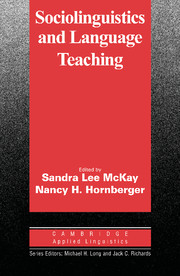Book contents
- Frontmatter
- Contents
- List of contributors
- Series editors' preface
- Preface
- Acknowledgements
- Part I LANGUAGE AND SOCIETY
- 1 Language attitudes, motivation, and standards
- 2 Societal multilingualism
- 3 World Englishes
- 4 Language planning and policy
- Part II LANGUAGE AND VARIATION
- Part III LANGUAGE AND INTERACTION
- Part IV LANGUAGE AND CULTURE
- CONCLUSION
- Index
2 - Societal multilingualism
Published online by Cambridge University Press: 22 July 2009
- Frontmatter
- Contents
- List of contributors
- Series editors' preface
- Preface
- Acknowledgements
- Part I LANGUAGE AND SOCIETY
- 1 Language attitudes, motivation, and standards
- 2 Societal multilingualism
- 3 World Englishes
- 4 Language planning and policy
- Part II LANGUAGE AND VARIATION
- Part III LANGUAGE AND INTERACTION
- Part IV LANGUAGE AND CULTURE
- CONCLUSION
- Index
Summary
Introduction
The terms bilingualism and multilingualism have been used interchangeably in the literature to refer to the knowledge or use of more than one language by an individual or a community. This practice will be continued here, but we must allow for the possibility that multilingualism may be more than just a magnified version of bilingualism. Multilingualism can be, and has been, studied both as an individual and as a societal phenomenon. When it is viewed as an individual phenomenon, issues such as how one acquires two or more languages in childhood or later, how these languages are represented in the mind, and how they are accessed for speaking and writing and for comprehension become central. When it is viewed as a societal phenomenon, one is concerned with its institutional dimensions, that is, with issues such as the status and roles of the languages in a given society, attitudes toward languages, determinants of language choice, the symbolic and practical uses of the languages, and the correlations between language use and social factors such as ethnicity, religion, and class. In this chapter, selected aspects of multilingualism as a societal phenomenon and their implications for language teaching are discussed.
Bilingualism is a worldwide phenomenon. Most nations have speakers of more than one language. Hundreds of millions of people the world over routinely make use of two or three or four languages in their daily lives.
- Type
- Chapter
- Information
- Sociolinguistics and Language Teaching , pp. 47 - 70Publisher: Cambridge University PressPrint publication year: 1995
- 7
- Cited by

